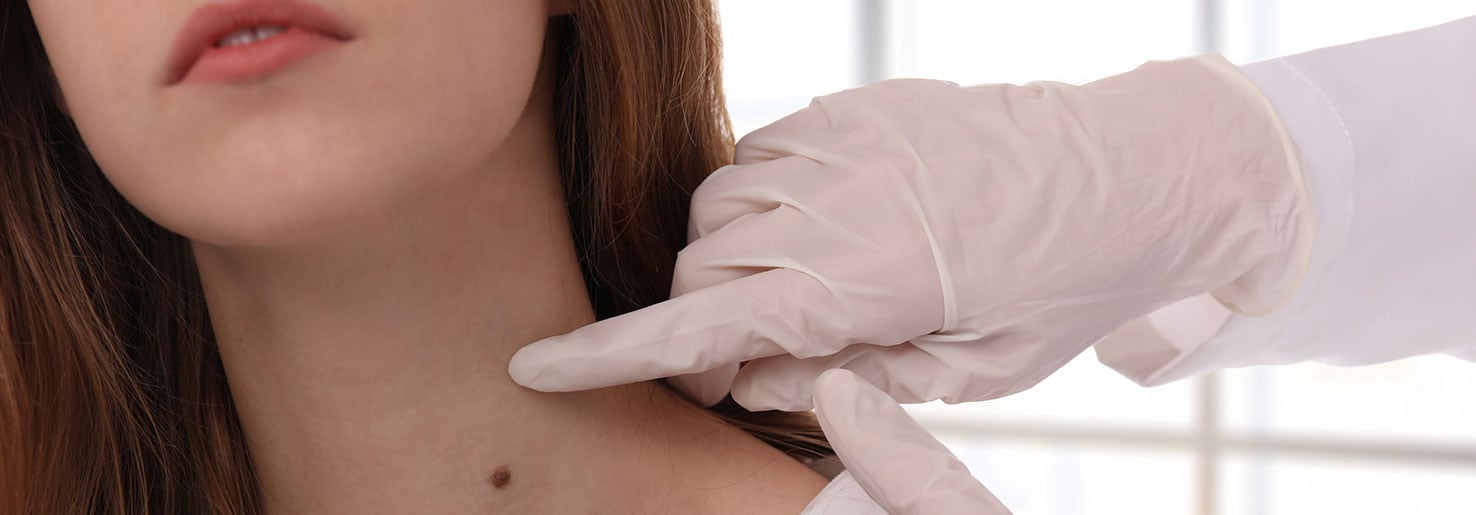
Understanding Skin Moles
Moles are noncancerous skin growths that develop when melanocytes—the cells that give the skin its color—bind together and form clusters instead of remaining evenly distributed throughout the epidermis (deepest skin layer). Just about everyone has at least a few moles, which may be present at birth or appear later, sometimes after sun exposure. Most moles are harmless and “typical,” which means they look like the other moles on the body.
Also known as common moles, typical moles rarely become cancerous. However, melanoma—the most serious and aggressive form of skin cancer—also develops in melanocytes. Because melanoma skin spots can resemble moles, it is important for everyone to understand the difference, become familiar with the moles on their body and learn to identify atypical moles and signs of skin cancer.
What do common moles look like?
Moles can be found anywhere on the body, even in areas that are rarely or never exposed to the sun, such as the scalp, armpits, genitals, under the nails and between the fingers and toes. Although common moles can be either flat or slightly domed, they are almost always:
- Round or oval in shape
- Symmetrical, which means that if a line were drawn through the middle, the two halves would match
- Consistent in color, usually a shade of black, brown, tan, beige or pink
- Smooth in texture
- Clearly defined by a distinct border
- Smaller than a pencil eraser (approximately .25 inches in diameter)
Some moles form over a hair follicle in the skin. Over time, the hair may grow through the mole and poke out of its surface.
What is the difference between a mole and a skin tag?
Skin tags are another type of benign skin growth. But unlike moles, which are composed of melanocytes, skin tags are made of skin, fat, fibrous tissues and blood vessels. Typically, they are flesh-colored and attached to a stalk (pedicle) that protrudes from the skin.
While skin tags can form anywhere on the body, they frequently develop in skin folds and areas exposed to friction, such as the neck, armpits and groin. Their causes are unknown, but many experts believe there may be a genetic link. Skin tags are also associated with certain metabolic conditions, including prediabetes, type 2 diabetes, polycystic ovarian syndrome (PCOS) and obesity.
What is an atypical mole?
In general, an atypical mole is any mole that looks different than the other moles on the body. To help people identify atypical moles, many physicians suggest using the simple acronym “ABCDE,” which stands for:
- Asymmetry – Unbalanced proportions
- Borders – Jagged or irregular edges that seem to fade into the surrounding skin
- Color – A combination of several shades ranging from black to light pink
- Diameter – Larger than .25 inches across
- Evolution – Changes in appearance over time
How does melanoma skin cancer form?
Melanoma arises when melanocytes undergo abnormal DNA changes that cause them to grow and divide uncontrollably. The excess skin cells then build up, bind together and form cancerous tumors.
The causes of the cellular changes that lead to the development of melanoma are not yet fully understood. However, most experts agree that a major risk factor for melanoma is exposure to harmful ultraviolet (UV) light from the sun and other sources, including indoor tanning beds, booths and lamps. Sunburns sustained during childhood are especially risky. UV radiation can damage cellular DNA, which controls cell growth and division. Cancer develops when damaged cells reproduce.
Melanoma is the least common but most dangerous type of skin cancer. It can potentially grow deep into the skin, invade blood vessels and spread to lymph nodes and distant areas of the body. However, when detected early, melanoma can often be cured with surgery.
What to do if you notice an atypical mole
Atypical moles are not skin cancer. Although a small percentage of melanomas begin in existing moles, the majority develop as a new, unusual skin spot that is unrelated to a mole. However, atypical moles and cancerous skin lesions share many of the same characteristics, and only a trained medical professional can determine the difference with certainty.
For this reason, it is important to have an atypical mole promptly evaluated by a physician. Using a special handheld magnifying device (dermatoscope), a physician can visualize skin characteristics that cannot be seen with the naked eye. If the physician suspects skin cancer, they will typically order a biopsy to confirm the diagnosis. If so, all or part of the mole will be removed for analysis under a microscope by a pathologist.
The Moffitt Cancer Center difference
Moffitt is proud to be home to the Donald A. Adam Melanoma and Skin Cancer Center of Excellence, a world-leading research program that leverages science to bring practice-changing approaches to our clinic. Our groundbreaking research is recognized by the National Cancer Institute and has earned us the prestigious designation of Comprehensive Cancer Center.
The multispecialty team in our renowned Cutaneous Oncology Program specializes in the diagnosis and treatment of melanoma and other forms of skin cancer. Significantly, Moffitt is a high-volume cancer center, which means our physicians have opportunities to treat both common and rare cancers. Our extensive expertise directly translates to better outcomes and quality of life for our patients.
If you would like to learn more about moles and skin cancer, you can request an appointment with a skin cancer specialist at Moffitt. Please call 1-888-663-3488 or submit a new patient registration form online. We do not require referrals.
